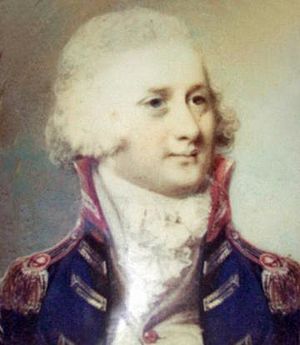John Clarkson (abolitionist) facts for kids
Quick facts for kids
John Clarkson
|
|
|---|---|

John Clarkson
|
|
| Born | 4 April 1764 Wisbech, Isle of Ely, England
|
| Died | 2 April 1828 (aged 63) Woodbridge, Suffolk, England
|
| Occupation | Naval lieutenant, governor. |
| Known for | Abolitionism, a founder of Freetown, Sierra Leone |
| Spouse(s) | Susannah Lee |
| Children | Ten |
| Parent(s) |
|
| Relatives | Thomas Clarkson, brother |
| Military career | |
| Allegiance | United Kingdom |
| Service/ |
Royal Navy |
| Years of service | c. 1777-? |
| Rank | Lieutenant (commissioned March 1783) |
Lieutenant John Clarkson (born April 4, 1764 – died April 2, 1828) was a British naval officer. He was also an abolitionist, meaning he worked to end slavery. John was the younger brother of Thomas Clarkson, who was a very important person in the fight against slavery in England.
As an agent for the Sierra Leone Company, John Clarkson played a big part in starting Freetown. This city is now the capital of Sierra Leone. Freetown was created as a safe place for African-Americans who had been freed from slavery. Many of them had first moved to Nova Scotia in Canada after the American Revolutionary War.
John Clarkson not only helped found Freetown, but he was also its first governor. Because of his work, he is seen as one of the founding fathers of Sierra Leone. People in Sierra Leone still remember his last prayer in Freetown. To the Nova Scotians, Governor Clarkson was like a "Father" and a "Moses" who led them to a promised land. In 1816, John Clarkson became a pacifist, someone who believes in peace and avoids war. He helped start the Society for the Promotion of Permanent and Universal Peace with his brother Thomas.
Contents
John Clarkson was born in Wisbech, England, in 1764. His father was a headmaster at Wisbech Grammar School. John went to this school until he was 12 years old.
In 1777, at age 12, he joined the Royal Navy. He became a lieutenant in 1783. He mostly served in the Caribbean Sea. There, he saw how cruel and unfair the slave trade was.
At first, he wasn't deeply affected by what he saw. But later, his brother Thomas, who strongly believed slavery was wrong, influenced him. John then began to hate slavery and actively helped the movement to end it.
Mission to America: Finding Settlers
John's brother Thomas and others had created the Sierra Leone Company. Their plan was to help free Black people settle on the west coast of Africa. Lieutenant Clarkson's job was to find volunteers among Black communities in Nova Scotia, Canada. They would then move to the area near the Sierra Leone River.
The Black people in Nova Scotia were mostly former enslaved African-Americans. They were known as Black Loyalists. They had escaped slavery and fought with the British during the American Revolutionary War to gain their freedom. The British had promised them land and supplies in Nova Scotia. However, these settlements often didn't get enough money. White Loyalists were often favored, which made things difficult for the freed people.
Clarkson arrived in Nova Scotia in October 1791. He worked with a Black Loyalist leader named Thomas Peters. Together, they gathered almost 1,200 African Nova Scotians. These people wanted to leave for a better life in Sierra Leone. Some even wanted to return to Africa, as they had been kidnapped from there as children.
They left on 15 ships for Africa on January 15, 1792. The journey across the Atlantic Ocean in winter was very hard. The ships arrived in Sierra Leone in March 1792. The Africans from Nova Scotia became known as the Nova Scotian Settlers. They founded Freetown. Clarkson stayed in the settlement until December 1792. He served as governor from August 1792 until he left.
Founding Freetown and Being Governor
Records show that Clarkson was a fair and supportive leader. The settlers respected him greatly. Even today, people in Sierra Leone remember Governor Clarkson as a just administrator. He was one of the most liked governors of Sierra Leone.
Clarkson deeply respected the settlers he worked with. He tried hard to make sure the Sierra Leone Company treated them fairly. When he returned to England, he spoke up for the settlers. He complained that the company was not keeping its promises to them. This led to the company eventually letting him go.
Clarkson never went back to Freetown. However, he met with settlers who traveled to England to fight for their rights in the colony. They succeeded in gaining political rights for themselves, even with governors who were not as understanding as Clarkson.
Later Life
On April 24, 1793, John Clarkson married Susan Lee. She was the daughter of a rich banker. They moved to Purfleet, England. There, John managed the estate of Mr. Whitbread, who owned a local brewery. He also managed Whitbread's quarry. John and Susan had ten children, but six of them died when they were young.
From 1816 to 1819, he was the treasurer for the Peace Society. In 1820, he left the Whitbread Company. He became a banker in Woodbridge, England, which was near his brother's home.
Death and Legacy
John Clarkson died on April 2, 1828, in Woodbridge, Suffolk. He was buried in the churchyard of St Mary's. His last words were about how terrible it was that slavery still existed. He said, "It is dreadful to think, after my brother and his friends have been working for forty years that such things should still be."
John Clarkson was played by Stephen Campbell Moore in a TV show called Rough Crossings (2007).
Images for kids



